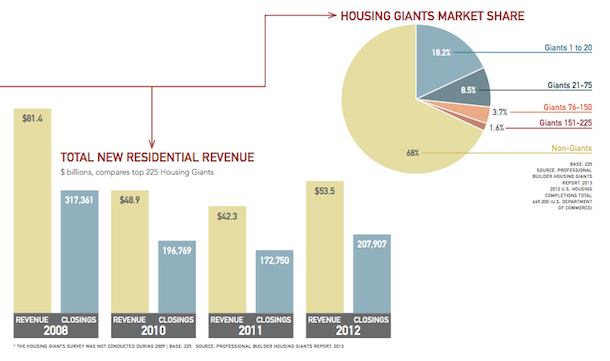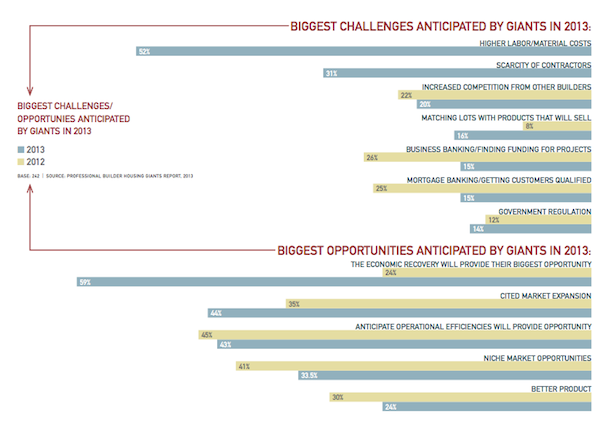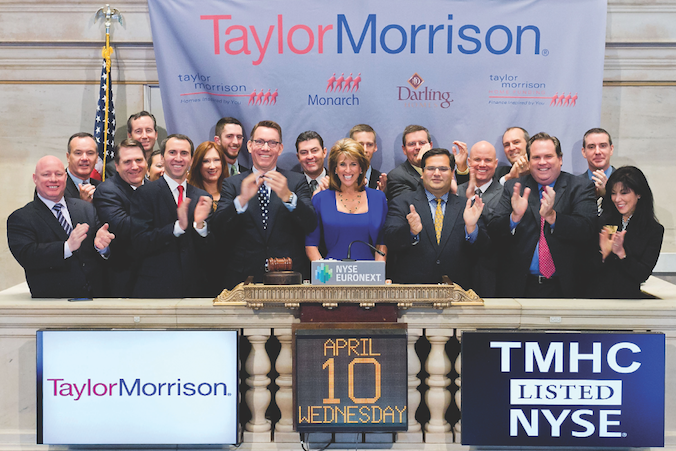When the New York Stock Exchange began the trading day on April 10, a home builder rang the opening bell. An honor reserved primarily for companies going public, this scene was unthinkable at any point over the past eight years. During the final stages of the housing bubble (2005 to 2007), investors were not buying shares in building stocks. After the bubble burst in 2007, investors waited through 2012 for the market to hit bottom before returning to housing stocks. For Sheryl Palmer, CEO of Taylor Morrison Homes—No. 9 on the 2013 list of Housing Giants—and the rest of the company’s leadership team, going public this spring was a satisfying culmination of years spent planning and preparing.
Taylor Morrison’s Road AheadQ&A with Sheryl Palmer, CEOFor Taylor Morrison CEO Sheryl Palmer, the April 10, 2013, initial public offering of company stock was a culmination of work that began in May 2006 when she accepted the CEO position of Morrison Homes. Previously, she had been a regional president for PulteGroup Inc., having started her career with Del Webb, which was acquired by Pulte Homes in 2000. Morrison Homes and Taylor Woodrow began merger talks soon after Palmer’s arrival and a deal was reached in July 2007.According to Palmer, the housing bust, in hindsight, gave the new company time to merge, regroup, and set on a new course. “We had a builder in Morrison Homes and we had a developer in Taylor Woodrow,” says Palmer. “It was about combining those two skills. It was about people, the land bank, and the ability to compete better.”Like most builders, Taylor Morrison had to trim its organization to match the downturn. In 2009 and 2010, the company avoided paying high prices for finished lots and instead bought large parcels in Arizona and Austin, Texas, to entitle in-house. Those lots are just now coming to market, says Palmer.PB: What was the rationale for Taylor Morrison to go public?Sheryl Palmer: It was the perfect time for Taylor Morrison to complete an IPO. We’re seeing strength across all of our markets. We have a strategic and diversified footprint and we are poised to take advantage of favorable trends in the housing market.PB: Operationally, have you implemented any new ideas to turn your homes around faster?SP: 2012 was a strong year for us, with a 39-percent increase in homebuilding revenues and a 46-percent increase in new orders. 2012 backlog increased 176 percent year-over-year; this is tangible evidence of the current strength of the home building industry.PB: Who’s buying your product these days?SP: We are seeing all buyer groups pursue home ownership with the greatest group in the recovery being recognized in the move-up buyer and the older adults. Our business is distinguished by our expertise in delivering lifestyle communities targeted at move-up buyers. Taylor Morrison is well positioned with our business mix diversified across markets, regions, customers, and price points.PB: Are you coming to the market with new product?SP: We spend considerable time understanding the wants and needs of our customers, and design our communities around those preferences and are constantly trying to align our projects with homebuyer demand. As such, we already build and sell a broad mix of homes in all of our markets across diverse price points.PB: Are you moving into any new locations? If so, where?SP: We carefully consider all opportunities to enter new markets, although we’re very happy with our current footprint. We are seeing strength across all of our markets, we have a strategic and diversified footprint, and we are poised to take advantage of favorable industry trends in the housing market.PB: What are your square footages?SP: We have a broad range of square footages starting with 400 sq. ft. studio units in our Canadian high rises, to 5,000-plus sq. ft. homes in the U.S.PB: Are you buying land? If so, where?
SP: We have significant land inventory, representing approximately 10.7 years of land supply, carried at a low cost basis that will more effectively enable us to execute our growth-focused business plan.
All of these developments ultimately led to Taylor Morrison’s successful $500 million initial public offering in April. Since that day, Taylor Morrison’s stock price, ticker symbol TMHC, rose steadily from $22 per share when the bell first rang, to $25.78 per share when this magazine went to press April 30.
The big get bigger
A new order: Horton No. 1
Methodology
Professional Builder has been compiling its list of Housing Giants for more than 40 years. Firms that wish to apply for the list must complete a questionnaire. In addition, Professional Builder retains the services of researchers who contact large building firms who have not volunteered information in order to cast the widest net for the biggest home-building firms. The rankings are based on new-home revenue only. Firms with less than 30 starts cannot be included in the ranking. To learn more or to inquire about applying for next year’s list, please contact Professional Builder’s awards coordinator Heidi Riedl at hriedl@sgcmail.com or (847) 391-1000.


Advertisement
Related Stories
Housing Giants
The 2024 Housing Giants Survey Is Now Open!
Complete the 2024 Housing Giants Survey to see if your company makes the cut in Pro Builder's rankings of the largest home building companies in the country
Housing Giants
Builder Rankings by Revenue: 2023 Housing Giants List
Pro Builder's annual Housing Giants rankings list provides a snapshot in time of builders’ perceived opportunities and challenges. These are the top 240 home builders in the nation, ranked by revenue
Housing Giants
Holding Back the Headwinds
Stormy market conditions strained the nation’s largest home builders in 2022, and they’re bracing for more uncertainty







